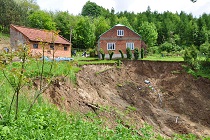 New methods of observation, greater powers of district governors and more precise definition of procedures - these are the changes introduced by the new regulation of the Minister of Climate and Environment on mass movements. The new regulations are effective as of February 18, 2021.
New methods of observation, greater powers of district governors and more precise definition of procedures - these are the changes introduced by the new regulation of the Minister of Climate and Environment on mass movements. The new regulations are effective as of February 18, 2021.
The regulation introduces modifications repeatedly postulated by geologists and representatives of public administration bodies. The changes will make it easier for local governments to carry out their tasks related to the inventory and observation of mass movements in both formal and practical terms. According to the regulation and current practice, a delineation of areas of mass movement occurrence will be carried out on the basis of geological mapping conducted by an expert in the field, without prematurely involving geological and engineering methods.
The new legislation clearly indicates that for the purpose of compilation of the register of landslides and areas prone to mass movement, the authorities may directly use the database of the Landslide Protection System (SOPO) provided by the Polish Geological Institute - National Research Institute (PGI-NRI), but they will still be able to prepare the appropriate maps and registration forms on their own. Their form and content has to be compliant with the Regulation and the "Manual for compiling maps of landslides and areas prone to mass movements" prepared by experts from PGI-NRI.
In addition, counties gain a new tool for conducting observations - field inspection. This is a relatively cheap and simple method of mass movement observation which does not require the presence of a geologist. It will allow quite fast assessment of the situation and the possible need to use complicated and expensive monitoring methods. As expected, the regulations concerning the frequency of observations are being liberalized - instead of biannual observations; one will be conducted every three years, unless there is a threat to human health and life or to property.
The new regulations organize the terminology, introduce a new type of mass movement registration form and introduce an observation protocol. The changes in regulations are to simplify the work of geologists and local governments, and thus have an impact on landslide risk reduction.

Damaged road and houses in a landslide in Szczepanowice (Pleśna commune, Tarnów county) (photo: Piotr Nescieruk)
Text: PGI-NRI Geohazard Center
Translated by Tomasz Trzpil (PGI-NRI)














 PGI-NRI offer
PGI-NRI offer Mineral resources of Poland
Mineral resources of Poland  Oil and Gas in Poland
Oil and Gas in Poland 




 Subscribe to RSS Feed
Subscribe to RSS Feed